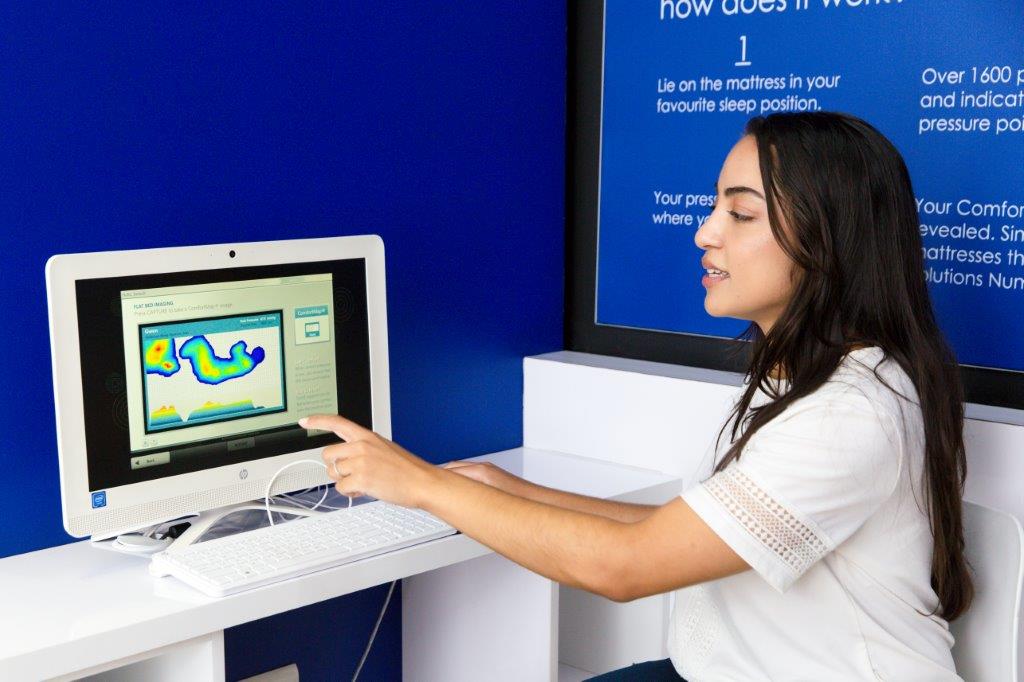Sleep is increasingly impacted by the world of technology making it an exciting time for innovation. Yet buying a mattress is still such a confusing exercise. Most people spend one or two minutes lying on a mattress they plan to sleep on for eight years or more. A risky investment that could cost you your health and mental well-being in the long run if made too quickly.
Pressure mapping technology, a computerized tool for measuring how weight is distributed across the surface of a mattress that originated in the health care sector to prevent pressure ulcers and improve patient comfort has found its way into mainstream mattress production and is taking the confusion out of choosing a mattress.
The Comfort Solutions Lab, launched by Bed King, maps a person’s sleep positions using pressure mapping technology which has over 1600 built-in pressure sensors that targets the body’s pain points creating the optimal sleep code that is then matched to three of twelve different mattresses all designed and manufactured locally by Bed King to complement each sleep code in three price ranges.
Pressure mapping sensors are ultra-thin pressure-sensitive resistors (aka, tactile array sensors) that are used to capture pressure data between nearly any two surfaces. Each sensor consists of intersecting rows and columns of conductive material. At each intersection is a layer of pressure-sensitive material. As pressure is applied to the sensing area, the resistance of the pressure-sensitive material changes. Scanning electronics connected to the sensor collects and converts this resistance change into digital signal, which is then transmitted to a computer for real-time analysis.
Based on the results, the sleeper is given a unique sleep code with their own Comfort Solutions number made up of a comfort and support ratio, e.g. 100/90. The comfort and support ratio is influenced by weight, body composition and sleeping position.
“The more pressure you have, the more comfort you will need in a mattress to relieve those pressure points,” explains Carla Ewertse-Myburgh, Operations Executive at Bed King, who launched their first store in South Africa 25 years ago. “Comfort is not measured by how soft a mattress is but by how much pressure its able to relieve. And if there is not enough comfort then you’ll find yourself tossing and turning the whole night trying to find comfort. The other factor is support and this is provided by the pocket spring units found in our mattresses.”
In order to understand the destruction of comfort levels, one needs to understand the presence of pressure on the body, in relation thereto. Clinical research in the United States continues to unpack the great controversy around mattress or bed surface design in the reduction of pain with specific reference to chronic pain, like neck or lower back pain.
Some studies provide evidence that foam bedding designs can in fact create symptoms of back pain, whereas other studies claim that medium-firm surfaces can actually reduce pain in individuals with back problems. While there is unclear evidence still today as to which industry design or comfort level works for which pressure concern, there are a few solid contributing factors that have been verified in the presence of pressure. These include body weight distribution, curvature of the body, posture positioning, sleep position, body temperature and pillow comfort.
Experts suggest a good night is sleep is between seven to nine hours for adults however in reality stats reveal that 1 in 3 adults suffer from symptoms of insomnia and as a result get less than seven hours of sleep a night. “There are so many distractions internally and externally that can keep us from falling asleep and staying asleep, which is why investing in a mattress and pillow that is designed to support your body during sleep is one way you can control your external environment,” says Carla.
Comfort is a mix of science and subjectivity. However, the search for the right mattress match, is the closest it’s ever been with the introduction of sleep codes. While the mattress industry takes most of the blame, it is up to the consumer to become more proactive, and particular, with their bed purchase – informing themselves of the right comfort solutions at their nearest bed store.
For more information visit https://www.bedking.co.za/comfort-solutions-lab


















